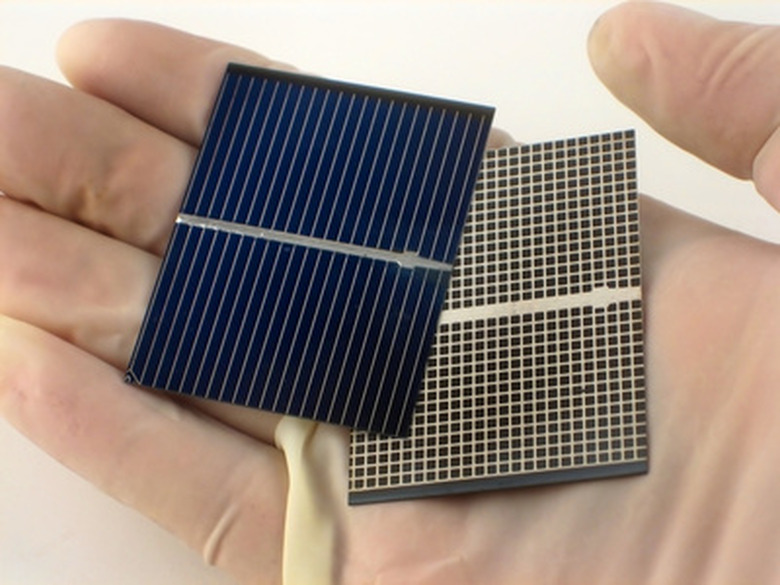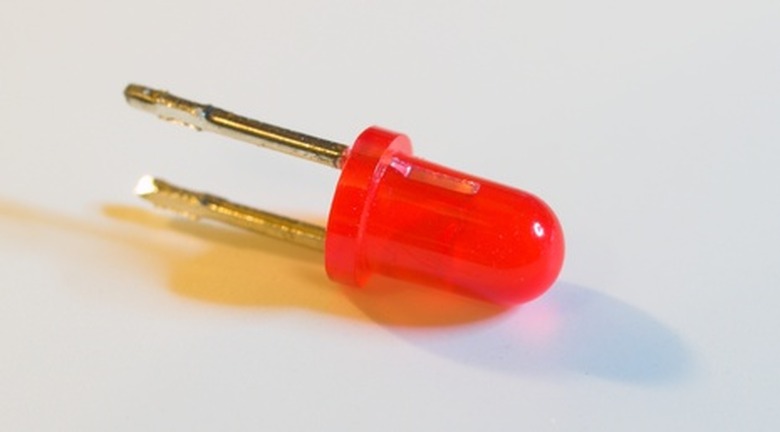How To Make An Easy Homemade Solar Cell Light Bulb For A Science Fair
A solar cell converts light into electricity. When light shines on a photocell, it produces a tiny amount of voltage. The voltage produced by a single solar cell is very small, about 1/2 volt. This is too small to drive a load; therefore, a number of solar cells are connected in series to produce a higher voltage. A solar panel, consisting of a number of solar cells, can be used to drive a load, such as a light bulb. It is fairly simple to make a solar cell-driven light bulb for a science fair.
Step 1
Strip about 1 inch of insulation from each end of a 1-foot long, red insulated wire and a 1-foot long, black. This can be done with a wire stripper, or light a candle, hold the end of a wire in the flame for a few seconds, take it out and pull off the insulation piece using pliers. Don't touch the wire end with bare hands immediately because it will be fairly hot.
Step 2
Identify a 3 V, 100 mA solar panel's positive and negative terminals. You should see two wires extending from the solar panel. In most cases, the positive wire is red and the negative wire is black, but colors may vary. Check the solar panel markings to identify the correct polarity. The negative polarity is the ground.
Step 3
Strip 1 inch of insulation from each of the solar panel's two wires. Use the method you used previously.
Step 4
Connect the solar panel's positive terminal wire to any one of the two wires of a 100-Ohm, 1/4-watt resistor. This can be done by holding both wires side by side and then twisting them together with fingers or pliers.
Step 5
Connect the other end of the resistor with the 1-foot long, red wire. Do this by placing their ends side by side and twisting them together with fingers or pliers.
Step 6
Connect the red wire's other end to the longer lead (positive) of a light-emitting diode (LED). Use the method you used previously.
Step 7
Connect the LED's shorter lead (negative) to the 1-foot long, black wire. Place the wire ends side by side and twist them together with fingers or pliers.
Step 8
Connect the black wire's other end to one of the two leads of a small, push-button switch. Because push-button switch leads are very stiff, you can simply wind the black wire around the lead to make the connection.
Step 9
Connect the push-button switch's other lead to the solar panel's negative (ground) wire. Use the method you used previously.
Step 10
Press the switch's push button. This will light the LED. Do not keep the light on for more than a few seconds because it may burn the LED. You may push the button, however, as many times and as often as you want.
Things Needed
- Wire stripper or candle and match
- Red insulated wire, 1 foot
- Black insulated wire, 1 foot
- Pliers
- Solar panel with ratings 3 V, 100 mA
- 100-Ohm, 1/4-watt resistor
- Light-emitting diode (LED)
- Small, push-button switch
TL;DR (Too Long; Didn't Read)
If you want to make the project aesthetically appealing, you can use an electronic breadboard to make all connections. Most breadboards have connection diagrams printed on their back. Use that guide to connect all the components.
Warning
If you use a candle to strip wires, do so under an adult's supervision. Also, never touch the end of a wire with bare hand immediately after taking it out of a candle flame; use pliers to strip the insulation.
Never use your teeth to strip wires. The insulation plastic is not edible and can cause health problems if ingested.
References
Cite This Article
MLA
Ahmed, Naeem. "How To Make An Easy Homemade Solar Cell Light Bulb For A Science Fair" sciencing.com, https://www.sciencing.com/make-light-bulb-science-fair-6717549/. 24 April 2017.
APA
Ahmed, Naeem. (2017, April 24). How To Make An Easy Homemade Solar Cell Light Bulb For A Science Fair. sciencing.com. Retrieved from https://www.sciencing.com/make-light-bulb-science-fair-6717549/
Chicago
Ahmed, Naeem. How To Make An Easy Homemade Solar Cell Light Bulb For A Science Fair last modified August 30, 2022. https://www.sciencing.com/make-light-bulb-science-fair-6717549/

